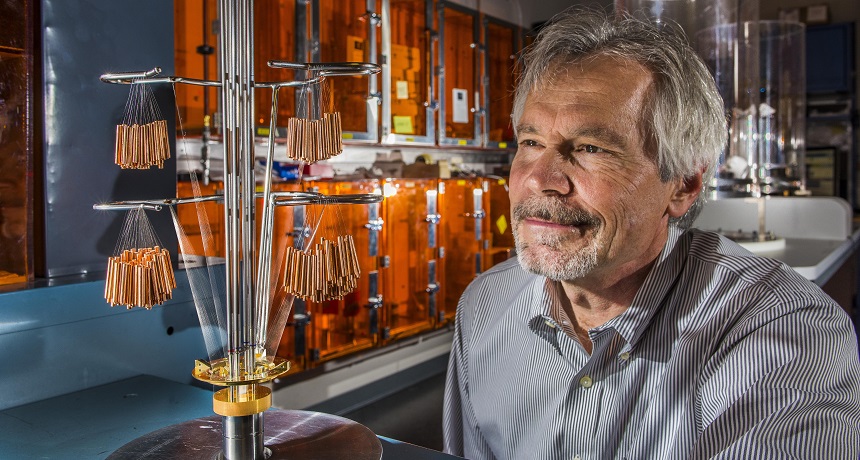Machine simulates the sun’s core
By heating iron atoms to more than 2 million degrees, scientists helped solve a solar mystery

Physicist Jim Bailey inspects a wire array that’s used to heat materials to extreme temperatures in the “Z Machine.” Bailey’s team used the device to study what happens to iron in the sun’s core.
Randy Montoya
By Ilima Loomis
Talk about turning up the heat! Scientists zapped tiny particles of iron and heated them to a temperature of more than 2.1 million degrees. What they learned from doing that is helping solve a mystery about how heat moves through the sun.
In the past, scientists could study the sun only by observing it from far away. They put those data together with what they knew about the sun’s makeup and formed theories about how the star works. But because of the sun’s extreme heat and pressures, scientists never could put those theories to the test. Until now.
Scientists at Sandia National Laboratories in Albuquerque, N.M., worked with the world’s largest pulse-power generator. Simply put, this device stores up a huge amount of electrical energy. Then, all at once it releases that energy in a big burst that lasts less than a second. Using this “Z Machine,” Sandia scientists can heat something about the size of a grain of sand to temperatures that aren’t normally possible on Earth.
“We’re trying to recreate the conditions that exist inside the sun,” explains Jim Bailey. As a physicist at Sandia, he studies what happens to matter and radiation under extreme conditions. It took more than 10 years to figure out how to get the temperature and energy density high enough for this experiment, he says.
The first element they tested was iron. It’s one of the most important materials in the sun, in part because of its role in controlling the sun’s heat. Scientists knew that fusion reactions deep within the sun created heat, and that this heat moved outward. Scientists have calculated that that heat takes around a million years to reach the surface due to the sun’s great size and density.
Another reason it takes so long is because iron atoms in the sun’s interior absorb — and hold — some of the energy that passes by them. Scientists’ had calculated how that process should work. But the numbers they came up with didn’t match what physicists observed in the sun.
Bailey now thinks his team’s experiment partly solves that puzzle. When the researchers heated the iron to temperatures like those at the sun’s center, they found that the metal absorbed far more heat than scientists had expected. Using these data, their new calculations about how the sun should behave come much closer to what observations of the sun show.
“It’s an exciting result,” says Sarbani Basu. She’s an astrophysicist at Yale University in New Haven, Conn. The new finding helps sun scientists answer “one of the most crucial problems we’ve been facing,” she says.
But, she adds, the fact that the Sandia team could do the experiment at all might be just as important as its findings. If scientists can perform similar tests on other elements that are found in the sun, the findings might help solve more solar mysteries, she says.
“I’ve been wondering about this for a long time,” she says. “We’ve known for years that they were trying to do the experiment. So this is marvelous.”
Bailey agrees. “We’ve known about needing to do this for 100 years. And now we’re able.”
Power Words
(for more about Power Words, click here)
astrophysics An area of astronomy that deals with understanding the physical nature of stars and other objects in space. People who work in this field are known as astrophysicists.
atom The basic unit of a chemical element. Atoms are made up of a dense nucleus that contains positively charged protons and neutrally charged neutrons. The nucleus is orbited by a cloud of negatively charged electrons.
element (in chemistry) Each of more than one hundred substances for which the smallest unit of each is a single atom. Examples include hydrogen, oxygen, carbon, lithium and uranium.
fusion (in physics) The process of forcing together the nuclei of atoms. Also known as nuclear fusion.
physics The scientific study of the nature and properties of matter and energy.Scientists who work in this field are known as physicists.
radiation Energy, emitted by a source, that travels through space in waves or as moving subatomic particles. Examples include visible light, infrared energy and microwaves.
Sandia National Laboratories A series of research facilities run by the U.S. Department of Energy’s National Nuclear Security Administration. It was created in 1945 as the so-called “Z Division” of nearby Los Alamos Laboratory to design, build and test nuclear weapons. Over time, its mission expanded to the study of a broad range of science and technology issues, mostly related to energy production (including wind and solar to nuclear power). Most of Sandia’s roughly 10,000 employees work in Albuquerque, N.M, or at a second major facility in Livermore, Calif.
solar Having to do with the sun, including the light and energy it gives off.
star Thebasic building block from which galaxies are made. Stars develop when gravity compacts clouds of gas. When they become dense enough to sustain nuclear-fusion reactions, stars will emit light and sometimes other forms of electromagnetic radiation. The sun is our closest star.
theory (in science) A description of some aspect of the natural world based on extensive observations, tests and reason. A theory can also be a way of organizing a broad body of knowledge that applies in a broad range of circumstances to explain what will happen. Unlike the common definition of theory, a theory in science is not just a hunch.







